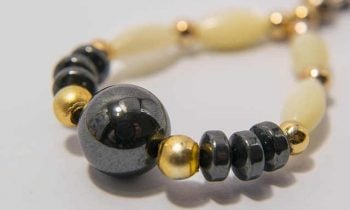Do you like black pearls? I simply love them. Why? Well, truly black pearls are extremely rare. Black pearls are produced from black-lipped oyster Pinctada margaritifera. It means that Pinctada is genus and margaritifera is species. Black pearls are produced by gigantic blackclipped oysters, which are scientifically named as pinctada margaritafera. This type of oysters can only be found if one would dive at least 40 meters under sea and as deep as 130 feet.
Though commonly called “Tahitian” pearls, Black pearls are actually grey to lighter or darker degrees. But, in addition, Black pearls have the unique ability to display a variety of colours at the same time, shimmering about their surfaces in varying shades – colours such as Peacock and Green. Black pearls are not actually black, but very dark gray, with overtones such as blue, green or purple.
For centuries, black pearls were prized for their rarity; most pearls are white, cream-colored or a very pale shade such as pink. Black pearls are made by black-lipped oysters that live in the Indian Oceans and the French Polynesian. They have an average size of around 8 to 17 millimeters and are the only pearls that come in a dark color naturally.
Black pearls are quite rare compared to white pearls. This definitely results in the expensiveness of the black pearls and thus makes them a collector’s item. So finding the perfect black pearl is quite a challenge.
So as you can see already black pearls are quite rare, have a beautiful luster unique to themselves and make stunning heirloom quality jewelry. For example, black pearls are cultivated in the black-lipped oyster because other oysters do not produce pearls of the same type.
Even though pearl farmers know the black-lipped oyster is essential to the cultivation of Tahitian black pearls, they don’t know yet how to consistently make it produce a specific color. Today, natural black pearls are very rare. They are usually found in lagoons covering dormant volcanoes, which release mineral salts.
For many of these reasons natural black pearls are rarer than white pearls, and black pearls from the Gulf of California have been valued since the Spanish arrived in the New World.
Cultured black pearls are also produced in the Gulf of California and in Tahiti. Long considered “mourning jewels” for royalty, black pearls are now the hottest fashion ticket in Europe and the United States. Much larger than Akoya pearls, black pearls are part of the large group of South Sea pearls, which includes many varieties of colored pearls produced outside Japan.
It is important not to forget that black pearls are also superior in color and quality to the freshwater white pearls. Japanese pearls are world-renowned and the best in the world.
The colors are artificially infused by a treatment known as dyeing, or by subjecting the pearls to irradiation. These treated colors are typically easy to spot by a trained observer who may peer down the drill hole looking for concentrations of color, which indicates the presence of dye, or a darkened pearl nucleus, which indicates radiation treatment.

 Black Pearls
Black Pearls Brand Name Bra
Brand Name Bra Cocktail Dress
Cocktail Dress Girlish Style Dress
Girlish Style Dress Choosing Sunglasses
Choosing Sunglasses